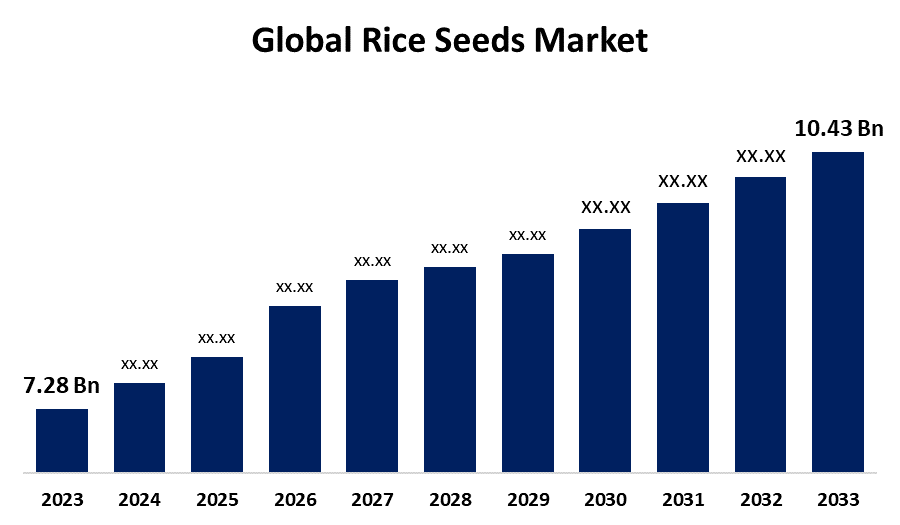Global Rice Seeds Market Size, Share, and COVID-19 Impact Analysis, By Type (Open-Pollinated Varieties and Commercial Hybrids), By Grain Size (Short Grain, Medium Grain, Long Grain), By Treatment (Treated and Untreated Seeds), and By Region (North America, Europe, Asia-Pacific, Latin America, Middle East, and Africa), Analysis and Forecast 2023 - 2033
Industry: AgricultureGlobal Rice Seeds Market Insights Forecasts to 2033
- The Global Rice Seeds Market Size was Estimated at USD 7.28 Billion in 2023
- The Market Size is Expected to Grow at a CAGR of around 3.66% From 2023 to 2033
- The Worldwide Rice Seeds Market Size is Expected to Reach USD 10.43 Billion By 2033
- Europe is expected to Grow the Fastest during the Forecast Period

Get more details on this report -
The Global rice seeds Market was Worth around USD 7.28 Billion in 2023 and is Predicted to Grow to around USD 10.43 Billion By 2033, With a Compound Annual Growth Rate (CAGR) of around 3.66% between 2023 and 2033. The Market is driven by a growing need for climate adaptability, technological developments in seed breeding, and rising demand for rice as a staple meal. Additionally, customers are increasingly looking for rice's nutritional advantages as they become more health conscious.
Market Overview
The rice seeds refer to a living grain that is utilized in the planting and cultivation of rice. The uncooked, unhulled grains that are selected from the rice crop at harvest are known as rice seeds. These can also be used as bioreactors to produce therapeutic proteins or peptides, which are used to make human pharmaceuticals. As customers look for food security in the face of expanding populations, there is a growing need for high-yield and disease-resistant rice cultivars. Crop productivity and sustainability are being improved through the adoption of biotechnology and seed production technologies. As a result, there is now a preference for specialized and organic rice. This tendency has been supported by rice seeds with higher yields and better flavors, which has increased market expansion. The consumption of brown rice has grown during the past few years in several Asian countries, including China, Vietnam, Malaysia, and India. The expansion of the rice seed market industry depends heavily on government support in the form of incentives, subsidies, and favorable laws. A lot of nations understand how important it is to support agricultural sustainability and guarantee food security. Governments promote the use of innovative seed technology by giving rice farmers resources and financial support. This assistance also includes funding research and development projects to create resilient and high-yield rice seed variants.
Report Coverage
This research report categorizes the rice seeds market based on various segments and regions, forecasts revenue growth, and analyzes trends in each submarket. The report analyses the key growth drivers, opportunities, and challenges influencing the rice seeds market. Recent market developments and competitive strategies such as expansion, type launch, development, partnership, merger, and acquisition have been included to draw the competitive landscape in the market. The report strategically identifies and profiles the key market players and analyses their core competencies in each sub-segment of the rice seeds market.
Global Rice Seeds Market Report Coverage
| Report Coverage | Details |
|---|---|
| Base Year: | 2023 |
| Market Size in 2023: | USD 7.28 Billion |
| Forecast Period: | 2023-2033 |
| Forecast Period CAGR 2023-2033 : | 3.66% |
| 2033 Value Projection: | USD 10.43 Billion |
| Historical Data for: | 2019-2022 |
| No. of Pages: | 230 |
| Tables, Charts & Figures: | 110 |
| Segments covered: | By Type, By Grain Size, By Treatment, By Region and COVID-19 Impact Analysis |
| Companies covered:: | Bayer AG, Advanta Seeds - UPL, Corteva Agriscience, BASF, SL Agritech Corporation (SLAC), Syngenta, NUZIVEEDU SEEDS LTD, RiceTec Inc., Horizon Ag, LLC, Hancock Seed & Company, Limagrain and others key vendors. |
| Pitfalls & Challenges: | COVID-19 Empact, Challenges, Future, Growth, & Analysis |
Get more details on this report -
Driving Factors
The need for high-quality, high-yielding rice seed varieties is fueled by the world's expanding population and rising demand for rice as a staple diet. Genetically modified and hybrid seeds, among other technological developments in seed breeding, are increasing productivity and resilience to diseases, pests, and climate change. The market is further driven by government assistance in the form of agricultural policies and subsidies, and new opportunities are created by increased rice farming in developing regions such as Africa and Latin America. Furthermore, the market is becoming more resilient and efficient as a result of the improved seed performance brought about by the adoption of precision agriculture and sustainable farming methods.
Restraining Factors
The market for rice seeds is hampered by some issues that affect its expansion. Small-scale farmers cannot afford the high prices of hybrid and genetically modified seeds, and their widespread adoption is hampered by a lack of awareness and distribution systems. Market expansion is further slowed by stringent government rules regarding GM crops and seed certification. Market expansion is further slowed by stringent government rules regarding GM crops and seed certification.
Market Segmentation
The rice seeds market share is classified into type, grain size, and treatment.
- The open-pollinated varieties segment accounted for the highest share in 2023 and is projected to grow at a substantial CAGR during the forecast period.
Based on the type, the rice seeds market is segmented into open-pollinated varieties, and commercial hybrids. Among these, the open-pollinated segment accounted for the highest share in 2023 and is projected to grow at a substantial CAGR during the forecast period. The enhanced attributes can be the demand for rice that is farmed naturally worldwide. The parent plants' natural pollination produced these rice types. To maintain genetic variation, these seeds can be self-pollinated or pollinated by birds, insects, and other natural processes. OPVs are regarded as standard varieties since they produce plants that are exactly like their parent plants, in contrast to hybrid seeds.
- The long grain segment accounted for a significant share in 2023 and is anticipated to grow at a remarkable CAGR during the forecast period.
Based on the grain size, the global rice seeds market is classified into short grain, medium grain, and long grain. Among these, the long grain segment accounted for a significant share in 2023 and is anticipated to grow at a remarkable CAGR during the forecast period. The enhanced attributes can be long-grain rice chosen by consumers who are increasingly searching for high-quality rice because of its distinct flavor, texture, and aroma. These seeds offer a higher yield, resistance to disease, adaptability to different climes, and culinary skill that ensures steady demand. Furthermore, due to their low glycemic index and potential health benefits, long-grain rice seeds are typically associated with healthier eating practices.
- The treated segment accounted for a significant share in 2023 and is anticipated to grow at a remarkable CAGR during the forecast period.
Based on the treatment, the global rice seeds market is divided into treated and untreated. Among these, the treated segment accounted for a significant share in 2023 and is anticipated to grow at a remarkable CAGR during the forecast period. The enhanced attributes can be for farmers, they provide greater protection, increased output, and cost-effectiveness. Higher germination rates and increased crop yields are ensured by treating these seeds chemically, biologically, or physically to increase their resilience to pests, diseases, and environmental stress.
Regional Segment Analysis of the Rice Seeds Market
- North America (U.S., Canada, Mexico)
- Europe (Germany, France, U.K., Italy, Spain, Rest of Europe)
- Asia-Pacific (China, Japan, India, Rest of APAC)
- South America (Brazil and the Rest of South America)
- The Middle East and Africa (UAE, South Africa, Rest of MEA)
Asia-Pacific is anticipated to hold the largest share of the rice seeds market over the predicted timeframe.

Get more details on this report -
Asia-Pacific is anticipated to hold the largest share of the Rice seeds market over the predicted period. The large-scale production, the region's high rice consumption, and the ideal growing climate. The need for high-quality rice seeds is fueled by the substantial contributions made by major rice-producing nations like China, India, Indonesia, Thailand, and Vietnam to global rice production and exports. Large tracts of agricultural land, government assistance in the form of subsidies and research funds, and ongoing developments in hybrid and genetically modified seed technology all contribute to the region's prosperity.
Europe is expected to grow at a rapid CAGR in the rice seeds market during the forecast period. The usage of rice in staple meals has grown in countries in the region, such as Italy, Spain, and several countries in the Southeastern region, such as Bosnia, Romania, Greece, and Turkey. It also contributes significantly to several traditional European dishes, particularly those involving Mediterranean cuisine. The demand for the products should rise as a result.
Competitive Analysis:
The report offers the appropriate analysis of the key organizations/companies involved within the rice seeds market along with a comparative evaluation primarily based on their type of offering, business overviews, geographic presence, business strategies, segment market share, and SWOT analysis. The report also provides an elaborative analysis focusing on the current news and developments of the companies, which includes type development, innovations, joint ventures, partnerships, mergers & acquisitions, strategic alliances, and others. This allows for the evaluation of the overall competition within the market.
List of Key Companies
- Bayer AG
- Advanta Seeds - UPL
- Corteva Agriscience
- BASF
- SL Agritech Corporation (SLAC)
- Syngenta
- NUZIVEEDU SEEDS LTD
- RiceTec Inc.
- Horizon Ag, LLC
- Hancock Seed & Company
- Limagrain
- Others
Key Target Audience
- Market Players
- Investors
- End-users
- Government Authorities
- Consulting And Research Firm
- Venture capitalists
- Value-Added Resellers (VARs)
Recent Development
- In June 2022, Bayer launched INH 16019, a hybrid rice seed exhibiting strong resistance to bacterial leaf blight (BLB) and brown planthopper (BPH). This development aims to improve yield stability and reduce crop losses due to these common pests and diseases.
Market Segment
This study forecasts revenue at global, regional, and country levels from 2023 to 2033. Spherical Insights has segmented the rice seeds market based on the below-mentioned segments:
Global Rice Seeds Market, By Type
- Open-Pollinated Varieties
- Commercial Hybrid
Global Rice Seeds Market, By Grain Size
- Short Grain
- Medium Grain
- Long Grain
Global Rice Seeds Market, By Treatment
- Treated
- Untreated
Global Rice Seeds Market, By Regional Analysis
- North America
- US
- Canada
- Mexico
- Europe
- Germany
- UK
- France
- Italy
- Spain
- Russia
- Rest of Europe
- Asia Pacific
- China
- Japan
- India
- South Korea
- Australia
- Rest of Asia Pacific
- South America
- Brazil
- Argentina
- Rest of South America
- Middle East & Africa
- UAE
- Saudi Arabia
- Qatar
- South Africa
- Rest of the Middle East & Africa
Frequently Asked Questions (FAQ)
-
1. What is the CAGR of the rice seeds market over the forecast period?The global rice seeds market is projected to expand at a CAGR of 3.66% during the forecast period.
-
2. What is the market size of the rice seeds market?The global rice seeds market size is expected to grow from USD 7.28 billion in 2023 to USD 10.43 billion by 2033, at a CAGR of 3.66% during the forecast period 2023-2033.
Need help to buy this report?